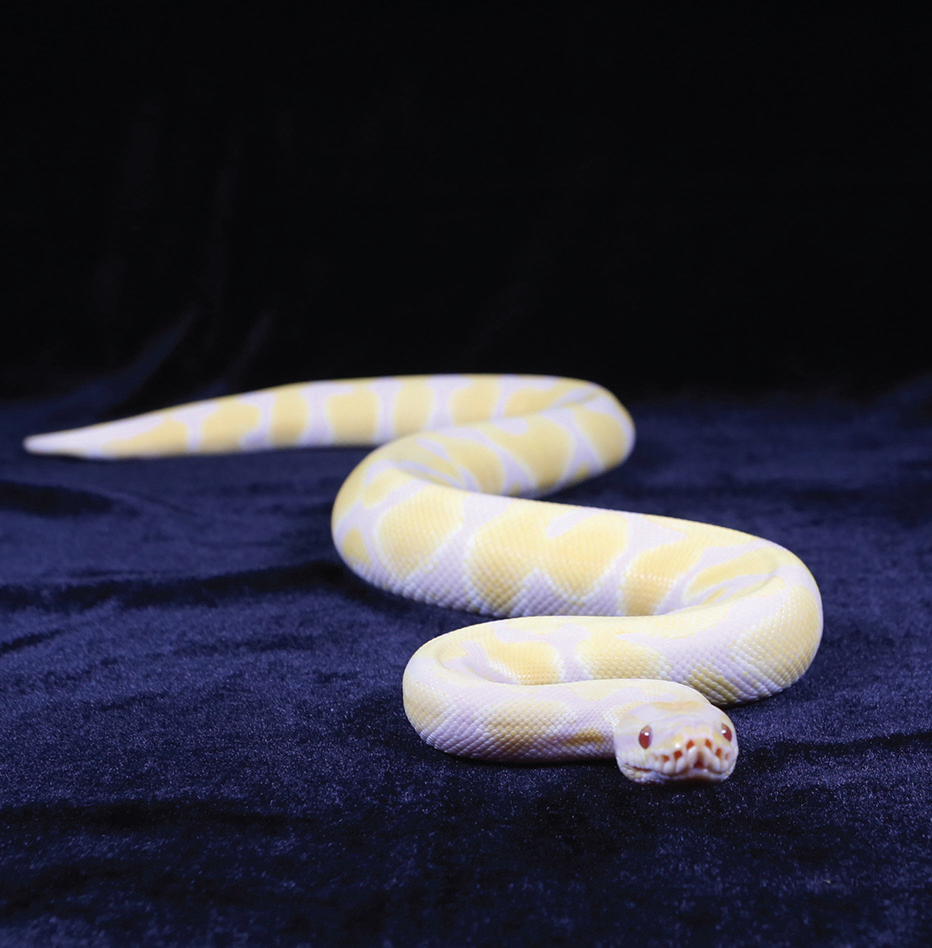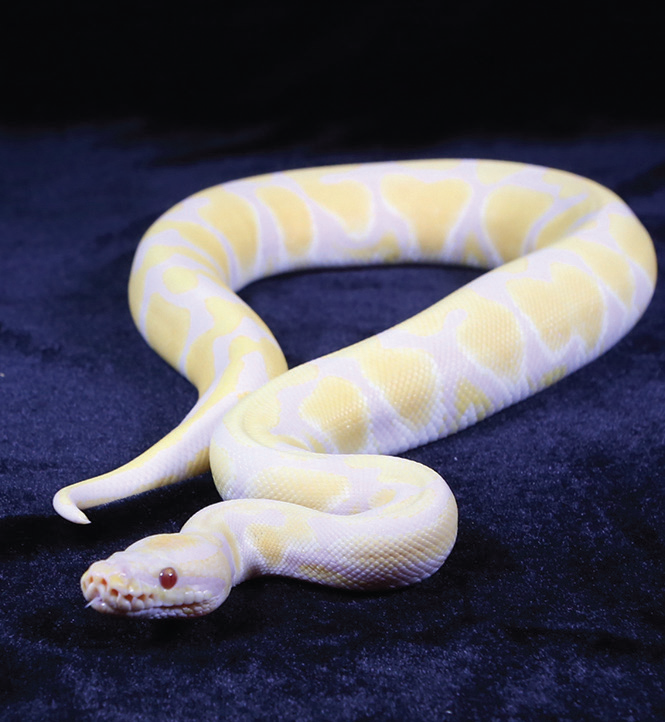BALLER BANDS
 From out of the dazzling array of ball python morphs comes the Toffino, a beautiful genetic cross between the Albino ball python and the Toffee ball python. The ball python, as you may know, is the most commonly kept snake in the world. Native to the warm tropical climate of central and western Africa, its popularity with herpetoculturists has brought the ball python to the United States, Europe (where it is also known as the royal python), and even the Philippines.
From out of the dazzling array of ball python morphs comes the Toffino, a beautiful genetic cross between the Albino ball python and the Toffee ball python. The ball python, as you may know, is the most commonly kept snake in the world. Native to the warm tropical climate of central and western Africa, its popularity with herpetoculturists has brought the ball python to the United States, Europe (where it is also known as the royal python), and even the Philippines.
Part of this is because of how easy to handle and docile the ball python is. Growing up to 3-5 feet long for females and 2-3 feet for males, this non-poisonous snake is more tolerant of being handled.
“The key to handling them is to be sensitive to their response when they are being handled,” says Pitlair. “If they feel tense or rapidly flee when you try to handle them, then give the snake time to get used to being handled. If the situation does not improve, then maybe that particular snake prefers not to be handled. Handling your snake may feel like a bonding experience for the handler but it may not necessarily be the same for the snake. Being handled may even be stressful for that particular snake.”
“They are simple to care for, like all other ball pythons,” he adds. “They eat the same staple prey items, like mice and rats, although other rodents and fowls are also available options.”
They require a terrarium or a rack system with a warm and cool side to help them regulate body temperature, since they are cold blooded. Fortunately, because the Philippines is a tropical country with a climate similar to that the ball python’s native habitat, they are quite at home here and tolerant of temperature changes, with the exception of high-altitude places like Baguio, where the air is colder and drier.
MORPH FOR ME
Another reason for the ball python’s popularity is the wide array of morphs, or inheritable visual traits, that this particular species of snake has exhibited. From the single wild type, known as the “Normal” within the keeper community, dozens of other morphs have emerged. Some morph are dominant, like the spider, pinstripe, or the aforementioned normal morphs. Other morphs, such as the pastel or Mojave, are co-dominant, which means that a snake will exhibit one appearance if it receives one co-dominant gene, and another appearance if it receives a matched pair from its parents.
Finally, many morphs are recessive, which means that a snake must receive a matched gene pair before it exhibits a visual difference. Axanthics, albinos, Toffees, and Tofinos are a few examples of recessive ball python morphs.
GRAND TOFFINO

The Toffino is often confused with the Toffee, especially when they are babies, says ball python
expert Pitlair. “The Toffino is soft yellow with lilac color pattern, while the Toffee is yellow-brownish, with coffee-colored patterns and red eyes,” he explains. “Normally, this color pattern is desired by most people.”
So how does one go about breeding a Toffino? “Well, having a male and female snake would be the very basic requirement,” jokes Pitlair.
And although simply breeding two adult Toffinos may produce a few Toffinos in the clutch, not all of them may turn out bearing the Toffino visual trait. This is because the Toffino is a cross between two recessive genes, Toffee and Albino, and any given Toffino will pass on either an Albino gene or a Toffee gene, which may result in Albinos and Toffees being produced by two visual Toffinos.
Another, cheap way is to cross a heterozygous Toffee with a heterozygous Albino. This gives a 1 in 4 chance of producing a Toffino; that is, 1 Toffino for every 4 eggs in the clutch. Pitlair explains why this is the least ideal way of producing a Toffino: “The reason is because you would not be able to visually determine the genetics of the normal/wild looking babies in the clutch, meaning you wouldn’t know if they were just plain normal or a heterozygous Toffee or Albino.” This because normal/wild is a dominant gene, and a normal-looking python that is visually identical to a wild ball python may actually bear any number of recessive genes that will only visually manifest in the next generation.
The ideal way to produce the Toffino, then, is to pair a visual Albino with a Visual Toffee. Both parents carry matched pairs of their respective recessive traits, and although this option costs the most, according to Pitlair, it is the best way because it guarantees that every single baby produced from this pairing will be a Toffino.
The Toffino is a key ingredient in creating many different, beautiful morph combinations, which is what made Pitlair decide to breed and keep them. “They are still very sought after because there are not that many of them available here in the Philippines, relative to the other morphs.” Perhaps through the efforts of expert keepers like Pitlair we can hope to see more specimens of this striking morph in the future.
This appeared in Animal Scene magazine’s June 2017 issue.






